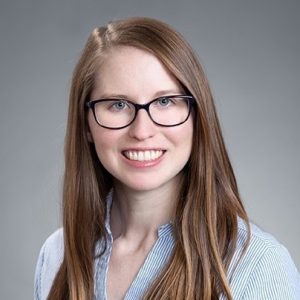Alexis Garrett: Rapidly printing structured meat at University of Nebraska
 Steak, as opposed to ground meat, has a specific structure of muscle and fat that gives it the marbling and texture we expect. Current methods to create meat with that structure are very slow. Alexis is using a 3D manufacturing technique called stereolithography to rapidly build structured meat.
Steak, as opposed to ground meat, has a specific structure of muscle and fat that gives it the marbling and texture we expect. Current methods to create meat with that structure are very slow. Alexis is using a 3D manufacturing technique called stereolithography to rapidly build structured meat.
Allison Esperanza: Maximizing protein production at University of Bath
 Cultured meat will require serum-free media and high-volume bioreactors for large-scale cell production. The complex biological conditions, such as media composition and bioreactor operating parameters, must be optimized together to achieve maximum cell growth. Allison is designing serum-free media while accounting for the constraints of bioreactor scale-up to maximize protein production.
Cultured meat will require serum-free media and high-volume bioreactors for large-scale cell production. The complex biological conditions, such as media composition and bioreactor operating parameters, must be optimized together to achieve maximum cell growth. Allison is designing serum-free media while accounting for the constraints of bioreactor scale-up to maximize protein production.
Rick Thyden: Culturing a hot dog using plants at Worcester Polytechnic Institute
 Rick estimates that to make one cell-cultured hotdog, he would need to grow 1,958,000,000 muscle cells! The only feasible way to reach that number is by using a conventional bioreactor with cell carriers—tiny particles to which the cells attach while suspended in media. Rick is developing plant-based microcarriers so that his final hotdog is fully edible!
Rick estimates that to make one cell-cultured hotdog, he would need to grow 1,958,000,000 muscle cells! The only feasible way to reach that number is by using a conventional bioreactor with cell carriers—tiny particles to which the cells attach while suspended in media. Rick is developing plant-based microcarriers so that his final hotdog is fully edible!
Sophie Letcher: Using voltage to control cell growth at Tufts University
 Did you know that the surface of a cell has a voltage, like a battery? Changes in this voltage affect the growth and differentiation of cells. Sophie is studying how voltage changes affect muscle cells for cultured meat. She is also looking at how ion channels on the cell surface, which alter the voltage, play a role in cell growth.
Did you know that the surface of a cell has a voltage, like a battery? Changes in this voltage affect the growth and differentiation of cells. Sophie is studying how voltage changes affect muscle cells for cultured meat. She is also looking at how ion channels on the cell surface, which alter the voltage, play a role in cell growth.
Vanessa Haley-Benjamin: Molluscan cell culture for sustainable seafood at University of Auckland
 Compared to terrestrial species, little is known about in vitro cell culture for marine invertebrates. Vanessa is laying the groundwork for abalone and oyster stem cell culture in order to relieve pressure on natural marine ecosystems. Her work will establish stem cell markers and develop media conditions for cell growth.
Compared to terrestrial species, little is known about in vitro cell culture for marine invertebrates. Vanessa is laying the groundwork for abalone and oyster stem cell culture in order to relieve pressure on natural marine ecosystems. Her work will establish stem cell markers and develop media conditions for cell growth.
Lily Westerhoff: Controlling cell detachment for continuous culture at University of Bath
 Continuous, rather than batch, bioreactor methods are a promising strategy to improve the efficiency of cultured meat production. Lily is designing methods for online cell detachment and harvest from inside hollow fiber bioreactors. This will facilitate continuous processing methods and accelerate the scale-up of cultured meat.
Continuous, rather than batch, bioreactor methods are a promising strategy to improve the efficiency of cultured meat production. Lily is designing methods for online cell detachment and harvest from inside hollow fiber bioreactors. This will facilitate continuous processing methods and accelerate the scale-up of cultured meat.
Clarisse Beurrier: Building a life cycle assessment for future technologies at Cambridge University
 Theoretically, cell-based meat ought to be more sustainable, ethical, and safe than animal agriculture. Manufacturers, however, will need to design their processes to ensure this is true while maintaining low costs to achieve price parity with animal-derived products. Clarisse is performing a prospective life cycle assessment to inform future technological development and ensure cultured meat factories achieve these goals. In the future, companies could use her tool with their own data to make informed decisions.
Theoretically, cell-based meat ought to be more sustainable, ethical, and safe than animal agriculture. Manufacturers, however, will need to design their processes to ensure this is true while maintaining low costs to achieve price parity with animal-derived products. Clarisse is performing a prospective life cycle assessment to inform future technological development and ensure cultured meat factories achieve these goals. In the future, companies could use her tool with their own data to make informed decisions.
Jake Marko: Designing a media recycling system at Worcester Polytechnic Institute
 The materials required to perform large-scale cell culture are expensive and not particularly eco-friendly. Jake is addressing both cost and sustainability by designing a media recycling system to reduce the inputs for large-scale bioreactor systems. His goal is to create a micro-ecosystem that will clean up used media and recycle key nutrients back into the system. This would reduce water and energy costs for cheaper and more sustainable cell culture.
The materials required to perform large-scale cell culture are expensive and not particularly eco-friendly. Jake is addressing both cost and sustainability by designing a media recycling system to reduce the inputs for large-scale bioreactor systems. His goal is to create a micro-ecosystem that will clean up used media and recycle key nutrients back into the system. This would reduce water and energy costs for cheaper and more sustainable cell culture.
Julian Cohen: Improving cell attachment to cellulose at Tufts University
 Cellulose, a waste product of plant-based foods, is an edible, animal-free, and low-cost material. Those qualities make cellulose an ideal scaffold for cultured meat. Cells, however, don’t naturally attach well to cellulose. Julian is using a novel protein coating to make it easier for bovine satellite cells to attach to cellulose scaffolds.
Cellulose, a waste product of plant-based foods, is an edible, animal-free, and low-cost material. Those qualities make cellulose an ideal scaffold for cultured meat. Cells, however, don’t naturally attach well to cellulose. Julian is using a novel protein coating to make it easier for bovine satellite cells to attach to cellulose scaffolds.
Lisa Musgrove: Establishing crustacean cell culture at University of the Sunshine Coast
 Publicly available information about crustacean genomes and cell culture is sorely lacking. No crustacean cell lines exist, and the most relevant growth media is designed for vertebrates or insect cells. Lisa is mining existing and underutilized data to identify important growth factors specific to crustaceans. She will then use this information to establish a red claw crayfish cell line and culture media.
Publicly available information about crustacean genomes and cell culture is sorely lacking. No crustacean cell lines exist, and the most relevant growth media is designed for vertebrates or insect cells. Lisa is mining existing and underutilized data to identify important growth factors specific to crustaceans. She will then use this information to establish a red claw crayfish cell line and culture media.
Vicky Andriessen: Cell-cultured New Zealand lamb at University of Auckland
 New Zealand is known for its high-quality lamb meat. Vicky is laying the groundwork to culture New Zealand sheep cells for cultured meat. She will study muscle cell culture in both 2D and 3D to ensure the cells proliferate and differentiate into mature muscle.
New Zealand is known for its high-quality lamb meat. Vicky is laying the groundwork to culture New Zealand sheep cells for cultured meat. She will study muscle cell culture in both 2D and 3D to ensure the cells proliferate and differentiate into mature muscle.
Mike McLellan: Replacing serum with native cells at Tufts University & The Jackson Lab
 Fetal bovine serum, a media component used in standard cell culture, contains a complex mix of molecules that interact with cells and promote growth. Efforts to replace serum with an animal-free alternative will have to recreate the key components of serum. In the body, these molecules are often produced and released by other cells in the tissue. Mike is developing high-resolution maps of cellular interactions within muscle tissues to study how we could replace FBS with a muscle “support cell.”
Fetal bovine serum, a media component used in standard cell culture, contains a complex mix of molecules that interact with cells and promote growth. Efforts to replace serum with an animal-free alternative will have to recreate the key components of serum. In the body, these molecules are often produced and released by other cells in the tissue. Mike is developing high-resolution maps of cellular interactions within muscle tissues to study how we could replace FBS with a muscle “support cell.”
Jernej Vajda: Testing a novel bioreactor for blood vessel formation at University of Maribor
 One hurdle to culturing a thick piece of meat, like a steak, is delivering nutrients to the center of the muscle—a task normally accomplished by blood vessels. Jernej is testing a novel bioreactor design, developed by our partners at The Institute for Development of Advanced Applied Systems (IRNAS), that mimics the nutrient-distribution of the body to the center of a cultured cut of meat.
One hurdle to culturing a thick piece of meat, like a steak, is delivering nutrients to the center of the muscle—a task normally accomplished by blood vessels. Jernej is testing a novel bioreactor design, developed by our partners at The Institute for Development of Advanced Applied Systems (IRNAS), that mimics the nutrient-distribution of the body to the center of a cultured cut of meat.



